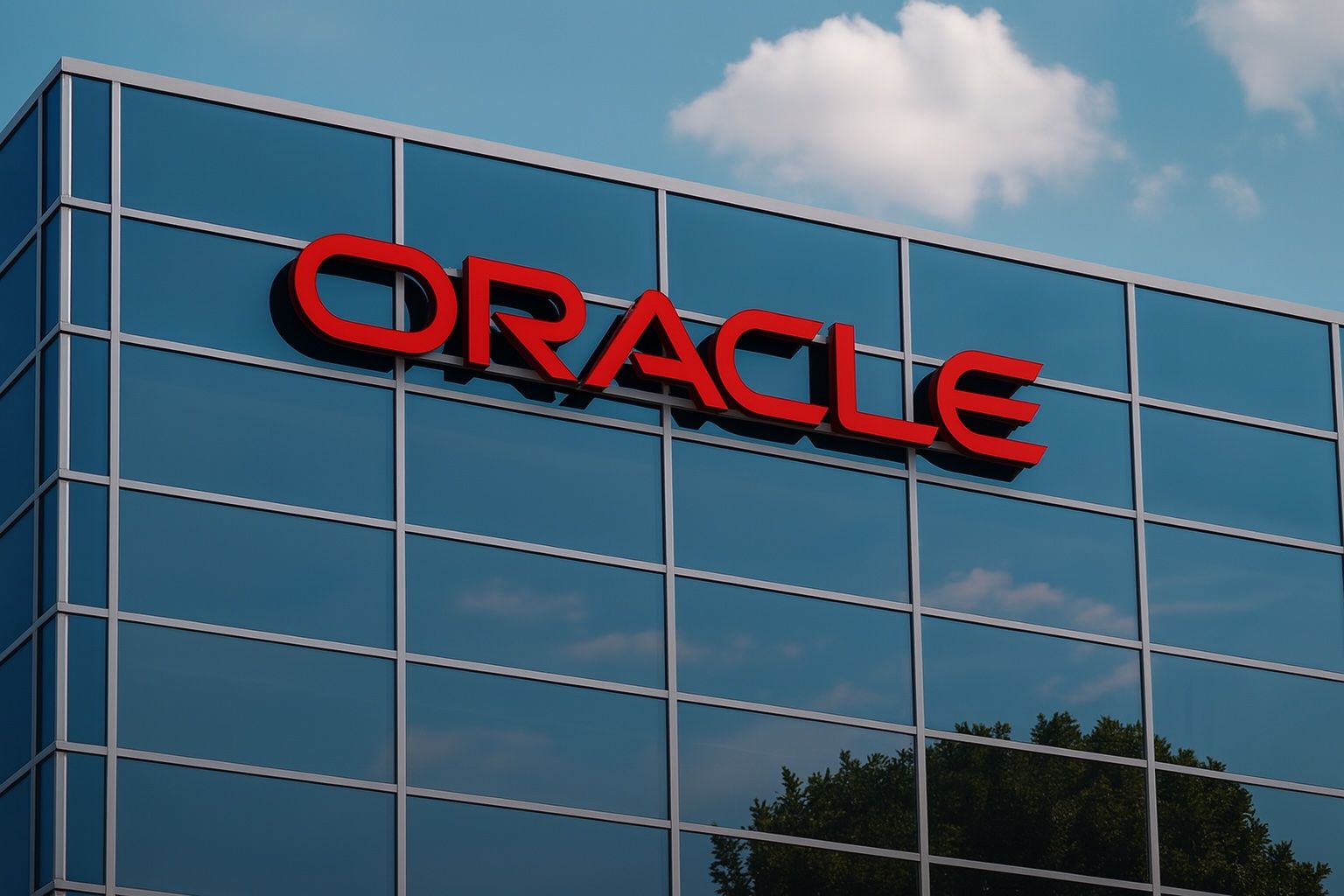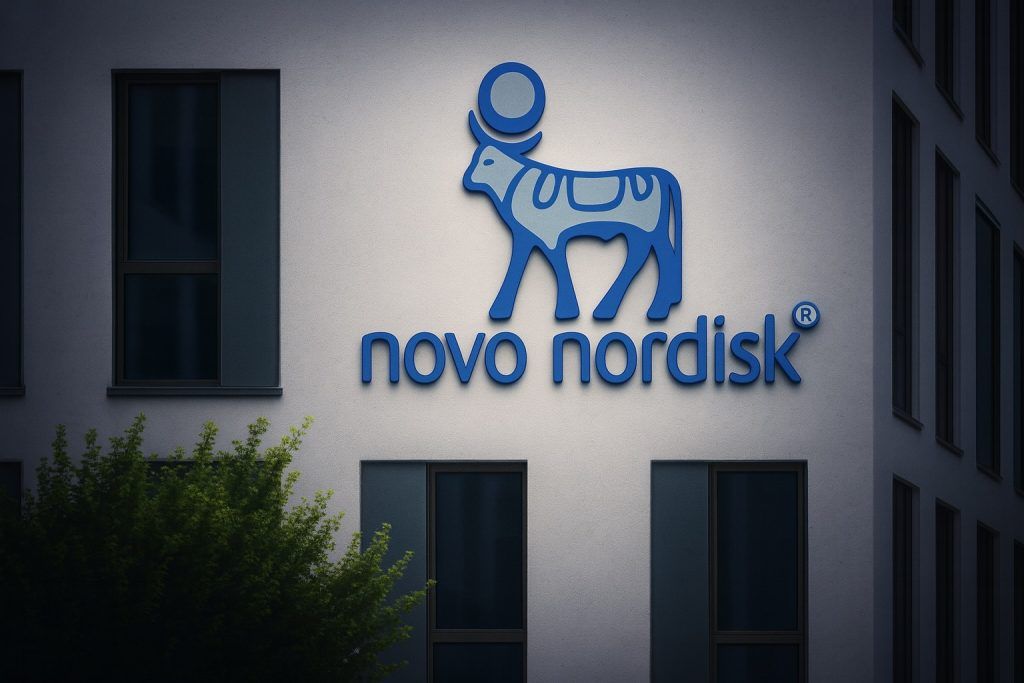- Stock Price Surge: Oracle Corporation (NYSE: ORCL) is trading around $304 per share as of October 17, 2025, roughly double its level at the start of the year [1]. The stock has climbed about 70–80% year-to-date amid investor excitement over Oracle’s massive cloud deals in artificial intelligence [2]. It hit an all-time intraday high near $345 in September before a modest pullback [3], and remains one of 2025’s top-performing tech stocks.
- Recent Rally & Volatility: Oracle shares spiked over 36% in a single day on September 10, 2025 – the company’s biggest one-day jump since the 1990s – after revelations of huge new AI cloud contracts [4]. That “stunning spike” added nearly $234 billion to Oracle’s market value and briefly valued the company around $913 billion, putting it within sight of the elite trillion-dollar club [5]. The stock later retraced ~15% from that peak on profit-taking and concerns about cloud profit margins [6]. Notably, a Bloomberg report warning of slim margins on Oracle’s AI cloud services (as low as ~14% gross margin) sparked a 6% one-day drop in early October [7]. Even so, ORCL remains up dramatically in 2025, far outpacing rivals like Microsoft and Alphabet [8].
- Blockbuster AI Contracts: Oracle’s latest earnings highlighted an unprecedented influx of AI-driven cloud business. In its fiscal Q1 2026 (reported Sept. 9), Oracle announced it had signed $300 billion in new AI cloud contracts across just a few customers [9]. OpenAI – maker of ChatGPT – alone was reported to be committing about $300 billion over five years for Oracle’s cloud computing power [10] [11], in what would be one of the largest cloud deals ever. Oracle’s remaining performance obligations (backlog) soared to $455 billion (up 359% year-on-year) as a result [12]. CEO Safra Catz touted that “over the next few months, we expect to sign up several additional multi-billion-dollar customers” and projected the backlog will exceed half a trillion dollars [13]. Buoyed by these deals, Oracle raised its guidance – forecasting Oracle Cloud Infrastructure (OCI) revenue to jump 77% this fiscal year (to about $18 billion) and reaching $144 billion annually by 2029/2030 [14].
- Strong Earnings Momentum: Oracle’s core business is growing at its fastest pace in years. Fiscal Q1 revenue came in at $14.93 billion (up 12% year-over-year), beating Wall Street expectations [15]. Cloud services (spanning SaaS and IaaS) grew 28% as enterprises rushed to Oracle’s platform for AI workloads [16]. The company’s aggressive investments in data centers are paying off in top-line growth, even as profit margins face pressure from the high cost of cutting-edge chips. Oracle’s net income and EPS were roughly flat in the quarter due to heavy spending, but executives and analysts emphasize the focus is on capturing cloud market share now for outsized profits later [17].
- Leadership Shake-Up: Oracle announced a surprise leadership change in late September. Longtime CEO Safra Catz will step down to become Vice Chair, while two senior cloud executives – Clay Magouyrk (OCI chief) and Mike Sicilia (Applications head) – have been appointed as co-CEOs effective later this year [18]. Company founder Larry Ellison remains Oracle’s Chairman and CTO, guiding product strategy. Analysts viewed the succession plan positively, seeing continuity in Oracle’s cloud direction. Evercore ISI noted that investors are familiar with Magouyrk and Sicilia and said “their promotions solidify the importance of the Cloud and Industry businesses as the growth levers for the company,” underscoring that the leadership transition is focused on Oracle’s key growth areas [19]. The smooth handover assuaged fears of disruption, and Oracle reiterated its confidence by reaffirming its financial outlook during the change [20].
- AI Product Launches & Partnerships: Oracle is rapidly expanding its AI offerings and alliances. At the Oracle AI World conference (Oct 15–16), the company unveiled a new Oracle AI Agent Marketplace for its Fusion Cloud Applications suite [21]. This marketplace lets customers easily deploy pre-built AI “agents” (intelligent assistants) in Oracle’s ERP, HR, CRM and supply chain apps. As Oracle’s cloud EVP Chris Leone explained, these tools enable enterprises to “fast-track enterprise AI adoption” by embedding AI into daily workflows without complex coding [22]. In parallel, Oracle is teaming up with major tech partners: for example, IBM announced it built three new AI agents on Oracle’s platform to automate finance and procurement tasks, deepening an Oracle–IBM AI partnership [23]. Oracle has also struck deals with once-rivals Microsoft, Amazon, and Google to integrate its cloud services with theirs, allowing those clouds’ customers to run workloads on Oracle Cloud OCI for improved performance [24]. This “multi-cloud” strategy – exemplified by an Oracle–Microsoft Azure interoperability pact – drove a +1,529% surge in Oracle’s revenue from other cloud providers running on OCI in Q1 [25]. Industry watchers note that Oracle is leveraging its deep enterprise software experience and embracing partnerships to carve out a unique niche in the booming AI cloud market [26] [27].
- Analyst Sentiment – Bullish but Cautious: Wall Street analysts have grown notably more optimistic on Oracle through 2025, though some urge caution on the lofty valuation. Jefferies called Oracle’s latest AI-fueled quarter “truly historic” and hiked its price target to $360 [28]. Many analysts now see Oracle as an emerging leader in cloud infrastructure for AI, crediting its successful transformation beyond its legacy database business. According to MarketBeat, the consensus 12-month price target is around $307 – roughly in line with the current stock price [29]. Several big banks like UBS and Bank of America have issued bullish targets in the mid-$300s, reflecting high expectations that Oracle’s cloud momentum will continue. However, not everyone is convinced: Oracle’s forward P/E ratio has ballooned to the mid-40s (far above historical levels), and skeptics worry the stock is “priced for perfection.” In a contrarian note, one Redburn analyst warned Oracle’s massive OpenAI deal is “very risky,” questioning if the full $300 billion will ever materialize [30]. That analyst slapped a Street-low $175 target on ORCL, arguing the market may be overestimating Oracle’s AI opportunity if costs remain high or demand falters [31]. The recent volatility reflects this debate: when Bloomberg highlighted Oracle’s slim profit margins on AI contracts, the stock tumbled 6% in a day [32]. Overall, analyst ratings average out to a cautious “Moderate Buy,” with an unusually wide range between bullish and bearish forecasts.
- Short-Term vs Long-Term Outlook: In the short term, Oracle’s growth story is outpacing its earnings. For the current fiscal year (ending May 2026), analysts expect Oracle’s revenue to rise ~15–16% [33] – a dramatic acceleration for a traditionally mature company – thanks to the flood of cloud bookings. Yet heavy capital spending on data centers and AI hardware is expected to keep earnings per share roughly flat around $6.70 [34]. This suggests Oracle is essentially reinvesting most of its new revenue into building capacity. Investors will be watching upcoming quarters to see if Oracle can sustain its cloud growth without eroding profitability. In the long term, bullish experts believe Oracle’s gambit could pay off enormously. Oracle itself projects OCI cloud revenue could grow from about $18 billion this year to $144 billion annually by FY2030 [35] – an astonishing eightfold increase. If that were achieved, Oracle’s total revenues would likely double or more in five years [36], potentially vaulting the company into the trillion-dollar market cap club alongside the likes of Apple and Microsoft. During last month’s surge, Oracle’s market value briefly neared $900 billion, hinting at that possibility [37]. To get there sustainably, Oracle will need to execute flawlessly: it must rapidly build out infrastructure, help its AI clients succeed, and fend off cloud mega-cap competitors – all while eventually improving its profit margins. “Oracle’s exceptional backlog confirms its new role – but now it must deliver,” one analyst emphasized [38]. The coming quarters will test whether Oracle can turn its AI cloud hype into lasting, profitable growth. If it can, the 2025 run-up will mark the start of Oracle’s next chapter as a true cloud powerhouse; if not, a reality check may await a stock that’s been on an historic tear.
Oracle Stock Update: Riding High on AI Frenzy
Oracle headquarters building. Oracle’s stock has been a standout performer in 2025 amid a frenzy for AI-related cloud services. Oracle’s stock price is hovering near $304 per share as of October 17, 2025, after a year of extraordinary gains driven by optimism around the company’s foray into artificial intelligence cloud services [39]. It closed at $303.98 on October 16 [40], essentially flat on the day, capping off a volatile few weeks. Just last month, Oracle shares touched a record intraday high of about $345.69 (on Sept. 10) following announcements of unprecedented AI cloud deals [41]. That one-day jump of over 36% on Sept. 10 added an estimated $234 billion to Oracle’s market capitalization [42], underscoring the euphoric reaction to Oracle’s new role as a major AI cloud provider. Since then, the stock has seen some turbulence – pulling back roughly 15–20% from its peak by early October [43] as investors digested Oracle’s rapid rise and took profits. In the first week of October, a report suggesting Oracle’s generative AI cloud business might have slim profit margins (potentially as low as ~14% on some services) triggered a sharp 6% sell-off in one day [44]. Still, those dips have done little to dent Oracle’s overall uptrend: the stock remains up about 70% year-to-date, vastly outperforming the broader tech sector and even outgaining high-fliers like Microsoft and Alphabet [45]. Oracle’s market cap is currently around $875 billion, making it the world’s fifth-largest tech company. With the share price now consolidating in the low $300s, traders are weighing how much of Oracle’s ambitious AI future is already “priced in” after the remarkable 2025 rally.
AI Mega-Deals Drive Record Backlog and Revenue Growth
Oracle’s recent financial results and contract wins have been nothing short of blockbuster. In its latest quarter (fiscal Q1 2026, covering June–August 2025), Oracle reported $14.93 billion in revenue – a strong 12% jump from the prior year period [46], and ahead of analyst expectations. This growth was propelled by Oracle’s cloud businesses, which saw a 28% surge as enterprises increasingly chose Oracle to run data-intensive AI workloads [47]. Oracle’s CEO Safra Catz highlighted on the earnings call that the company closed an “unprecedented” amount of large deals for its Oracle Cloud Infrastructure (OCI) in the quarter. In fact, Oracle disclosed it had signed four huge cloud contracts, collectively worth “many billions” of dollars [48]. While Oracle didn’t name all the clients, news reports indicated that OpenAI (the company behind ChatGPT) is a major one – reportedly agreeing to spend roughly $300 billion on Oracle’s cloud services over five years [49] [50]. That staggering commitment, if fully realized, would be among the largest cloud computing contracts in history. It explained much of Oracle’s recent stock frenzy and has been described by analysts as a “game-changer” for Oracle’s cloud credibility.
Thanks to the wave of new contracts, Oracle’s remaining performance obligation (RPO) – essentially its backlog of cloud revenue under contract – exploded to $455 billion in Q1, up 359% year-over-year [51]. To put that in perspective, Oracle’s backlog is now several times larger than its annual revenue, reflecting multi-year agreements that should keep its cloud data centers humming for a long time. On the earnings call, Safra Catz said Oracle expects to sign “several additional multi-billion-dollar customers” in the coming months and predicted the backlog will soon exceed $500 billion [52]. Oracle’s leadership is so confident in sustained demand that they raised the company’s outlook: Oracle now forecasts OCI revenue will surge 77% in the current fiscal year and reach about $18 billion, and they project OCI sales could hit $144 billion annually by fiscal 2029/2030 [53]. These rosy internal projections suggest Oracle sees its cloud business multiplying in size as AI adoption accelerates.
It’s worth noting that these huge cloud deals are not without challenges. Many involve significant upfront costs for Oracle – such as building new data centers loaded with high-end NVIDIA GPUs to serve AI customers. The recent Bloomberg analysis raising concern about thin margins underscored that Oracle might be sacrificing near-term profitability to secure its place in the AI race [54]. Credit agency Moody’s also weighed in, flagging risks around Oracle’s strategy of relying on a few colossal AI contracts. Moody’s noted the “counterparty risk” of depending on large spending commitments from a small number of customers (like OpenAI) and cautioned that Oracle’s debt levels are rising as it finances its data center expansion [55] [56]. In Moody’s view, Oracle’s cloud build-out is “one of the world’s largest project financings,” and free cash flow may be negative for an extended period [57]. Oracle’s executives, however, argue that these investments will pay off in a durable high-margin business once the infrastructure is in place and the contracts ramp up. For now, Oracle’s latest results show a company willing to trade off short-term profit for long-term cloud revenue – a gamble that has electrified investors, even as it carries some financial risk.
Executive Shake-Up Signals an AI-Focused Future
Another major development for Oracle this fall was a leadership transition at the very top. On September 22, Oracle announced that Safra Catz, the company’s CEO for the past decade, will step down from that role and move to the position of Vice Chair of the Board [58]. Catz has been instrumental in Oracle’s evolution (having served as co-CEO alongside the late Mark Hurd and then sole CEO since 2019), so her change of role initially raised some eyebrows. However, Oracle revealed a succession plan aimed at continuity: it appointed two experienced insiders, Clay Magouyrk and Mike Sicilia, as co-Chief Executives to jointly take the helm going forward [59]. Magouyrk runs Oracle’s Cloud Infrastructure division and Sicilia heads Oracle’s industry-specific applications unit – both are divisions central to Oracle’s cloud growth strategy. Meanwhile, company founder Larry Ellison will remain deeply involved as CTO and Chairman, continuing to drive Oracle’s technology roadmap (especially in databases and cloud services).
Market reaction to the management news was largely positive. Rather than viewing Catz’s move as a negative or a sign of internal strife, analysts saw the elevation of Magouyrk and Sicilia as a vote of confidence in Oracle’s cloud-centric direction. “Wall Street viewed this as a smooth succession,” noted Evercore ISI, which pointed out that investors are already familiar with the new co-CEOs [60]. Both executives have been the public faces of Oracle’s cloud push (Magouyrk, for instance, often speaks on OCI’s capabilities), so their promotion signals “the importance of the Cloud and Industry businesses” as key growth levers, in Evercore’s words [61]. In other words, Oracle is doubling down on the areas where it sees the most opportunity – cloud infrastructure and industry-tailored software – by putting their leaders in charge of the whole company. The appointment of two CEOs is unusual, but Oracle’s board indicated that Magouyrk and Sicilia’s complementary expertise would serve the broad scope of Oracle’s operations (from backend cloud tech to business applications). So far, investors have not reacted negatively; Oracle’s stock was stable around the announcement, suggesting confidence that Ellison and Catz have orchestrated a thoughtful succession. The company also reaffirmed its financial outlook at the time [62], implying no change in trajectory or strategy. As Oracle enters this new era, Safra Catz’s continued presence as Vice Chair (and one of Oracle’s largest stockholders) means the company will still have her guidance, while day-to-day leadership passes to a younger generation of cloud-focused executives.
New AI Offerings and Key Partnerships
Oracle’s product innovation engine has been in high gear, aiming to capitalize on the surging interest in artificial intelligence. During Oracle’s AI World 2025 conference in mid-October, the company announced a suite of AI-powered features across its software lineup. The centerpiece was the launch of an AI Agent Marketplace for Oracle’s Fusion Cloud Applications [63]. This is essentially a platform where Oracle and its partners can offer pre-built AI “agents” – think of them as intelligent assistants or mini-applications – that customers can plug into Oracle’s cloud software for automating various business tasks. For example, an AI agent in Oracle’s ERP system might automatically detect anomalies in invoices, or an agent in the HR system might handle recruiting inquiries with natural language. Oracle highlighted that dozens of partners (including big consulting firms like Accenture, Infosys, and IBM) contributed AI agents for the launch, addressing use cases from finance to customer service [64]. By allowing companies to “embed AI assistants directly in their workflows,” Oracle is trying to make AI adoption easier for enterprises that use its software [65]. “In the age of intelligent automation, these tools help organizations fast-track AI adoption,” explained Oracle executive Chris Leone, who oversees applications development [66]. The message: Oracle isn’t just providing cloud infrastructure for AI, it’s also weaving AI capabilities into the business applications that run on its cloud.
Beyond products, Oracle has been forging strategic partnerships to strengthen its position in AI and cloud. A standout example is its growing collaboration with IBM. At the same AI World event, IBM’s Watsonx team joined Oracle to announce new AI agents that run on Oracle’s cloud, such as tools to automate inter-company accounting and procurement workflows [67]. IBM’s Vice President Neil Dhar said “Oracle and IBM are combining our collective AI and transformation expertise” to help enterprise clients adopt these solutions [68]. This partnership is notable because Oracle and IBM historically competed in databases and enterprise software, but the AI era is pushing such companies to work together, blending Oracle’s cloud technology with IBM’s AI know-how for mutual benefit.
Oracle is also embracing a pragmatic multi-cloud strategy. Recognizing that many large customers use multiple cloud providers, Oracle has struck interoperability agreements so that its database and cloud services can be used from within other platforms. Over the past year, Oracle reached deals with Microsoft Azure, Amazon Web Services (AWS), and Google Cloud that allow those cloud customers to easily tap into Oracle’s specialized database services or connect to Oracle Cloud for high-performance computing needs [69]. For instance, Oracle and Microsoft launched “Oracle Database@Azure,” enabling Oracle’s database to run directly on Azure data centers with unified support. These tie-ups effectively turn rival cloud providers into channels for Oracle’s technology, and they appear to be yielding fruit: Oracle reported that revenue from other big-cloud customers running workloads on Oracle Cloud jumped 1,529% in the latest quarter [70]. It seems Oracle’s willingness to partner – even with competitors – is expanding its reach in the cloud market.
All told, Oracle’s recent product announcements and alliances underscore a strategic pivot from traditional database vendor to AI-era cloud player. The company is investing heavily in AI capabilities up and down its product stack, while also courting an ecosystem of partners to drive adoption. This approach could help differentiate Oracle in a crowded field. Whereas cloud giants like AWS and Google predominantly offer raw infrastructure, Oracle is trying to marry infrastructure with packaged business solutions and deep industry expertise. An analyst noted that Oracle’s “deep experience managing massive volumes of enterprise data” gives it credibility in delivering AI to large organizations [71]. Of course, Oracle faces stiff competition from those larger rivals – and they won’t sit still. But if Oracle can continue rolling out innovative AI offerings and leverage partnerships to win customers, it stands to grab a meaningful slice of the booming enterprise AI market.
Wall Street’s Take: Optimism with a Side of Caution
Oracle’s dramatic turnaround in 2025 has prompted a reevaluation on Wall Street. A year or two ago, Oracle was often seen as a slow-growth legacy tech name. Now, it’s increasingly viewed as a contender in the cloud computing big leagues – and analysts have been adjusting their forecasts accordingly. The consensus analyst rating for ORCL has improved to a “Moderate Buy” in recent months [72]. According to TipRanks data, about 30 analysts currently cover Oracle, with a majority recommending Buy or Overweight and the rest mostly neutral. The average 12-month price target across analysts now sits in the low-to-mid $300s per share [73]. MarketBeat’s compilation of targets pegs the consensus around $307 [74], which is only slightly above the latest price – indicating that after the huge rally, Oracle’s stock is close to fairly valued in the eyes of many analysts. However, there’s a wide dispersion in those targets, reflecting uncertainty about how Oracle’s gamble will play out. On the high end, some bulls see Oracle continuing to surprise to the upside: for example, Jefferies analyst Brent Thill was so impressed by Oracle’s AI-fueled growth that he termed the last quarter “truly historic” and boosted his target price to $360 [75]. A few optimists have even floated targets around $400 (implying new record highs ahead) if Oracle’s cloud business keeps beating expectations [76]. These bullish analysts argue that Oracle’s enormous cloud backlog and accelerating revenue haven’t been fully baked into the stock price yet – in their view, as Oracle starts to deliver on the contracts and revenue flows through to financial results, the stock could have another leg up.
On the other hand, bearish voices are cautioning that Oracle’s stock may have run too far, too fast. The most pessimistic 12-month target on the Street sits at just $175 [77] – a drastic drop from current levels – issued by an analyst at Redburn. That analyst made waves by calling Oracle’s OpenAI deal “very risky,” openly doubting whether OpenAI (a still unprofitable startup) can utilize or pay for $300 billion of cloud services as planned [78]. The skeptic’s thesis is that Oracle might end up overspending to build capacity for these AI customers, only to see usage fall short, leaving Oracle with a lot of data center costs and not enough revenue. He noted Oracle could have to take on significant debt to finance its expansion, potentially pushing its leverage to concerning levels [79]. Moreover, at roughly 40–50× earnings, Oracle’s stock valuation is now richer than most established software giants – so any stumble could trigger a sharp correction. A recent TipRanks commentary warned that Oracle is “trading on the best-case scenario, leaving little room for error,” advising a hold stance until more proof of profitable growth emerges [80]. Even bulls concede that Oracle’s current multiples assume a lot of success ahead. “Not all AI bets can win,” wrote one analyst, encapsulating the caution that while Oracle is making bold moves in AI, the outcome won’t be known for some time [81].
Investors also remember that high-growth stories can face growing pains. Oracle’s September surge was breathtaking, but the ensuing early-October dip showed how skittish the market can get on any hint of trouble. The fact that a single news piece about margins caused a multi-billion dollar selloff [82] suggests traders will be intensely sensitive to Oracle’s upcoming earnings reports and margin trends. Key indicators that analysts say they’ll be watching include: cloud consumption (are Oracle’s new AI clients actually utilizing the capacity they’ve reserved?), profit margins (does Oracle show it can improve cloud profitability as it scales up?), and competitive responses (do rivals cut prices or introduce products that steal Oracle’s thunder) [83]. Any signs of cloud growth deceleration or unexpectedly high costs could give the market jitters. For now, though, the prevailing sentiment leans optimistic – if cautious. As one market observer noted, Oracle’s stock rise this year has even outpaced the vaunted “Magnificent Seven” group of Big Tech stocks, a turn of events few saw coming [84]. That upside surprise is precisely why many analysts have been caught upgrading Oracle and revising their models.
In sum, Wall Street is effectively saying: Oracle’s prospects look better than they have in a long time, but the company has a lot to prove in the next 12–24 months. Oracle’s bold moves into AI have opened up a tantalizing new growth narrative – one where Oracle is a central player in the next wave of cloud and possibly a trillion-dollar enterprise someday [85]. Yet, until Oracle demonstrates that it can convert those huge bookings into sustainable revenue and profits, some level of skepticism will linger. The range of analyst opinions is unusually broad for a company of Oracle’s size, reflecting that mix of enthusiasm and uncertainty. Investors seem to be giving Oracle the benefit of the doubt for now, bidding the stock up on growth hopes. The coming quarterly results and AI deal updates will be crucial in determining whether that optimism continues to be rewarded or faces a reality check.
Forecast: Can Oracle Deliver on Lofty Expectations?
Looking ahead, the big question is whether Oracle can meet the towering expectations it has set. In the near term, Oracle’s financial results may not yet fully reflect the blockbuster deals announced – those will ramp up over multiple quarters or years. Analysts forecast Oracle’s total revenue for the current fiscal year (FY2026) will be around $66–67 billion [86], roughly 15% higher than last year, which would be Oracle’s fastest growth rate in over a decade. However, due to the heavy infrastructure investments, annual profit is forecast to be only marginally up (mid-single-digit EPS growth at best) [87]. This implies Oracle’s operating margins will be under pressure in the immediate future. Oracle’s own executives have acknowledged this trade-off: they are prioritizing capturing cloud market share now, with the expectation that profitability will follow later once economies of scale kick in. For shareholders, this means that over the next couple of quarters, success won’t necessarily be judged by big earnings beats, but rather by metrics like cloud revenue growth, backlog additions, and progress on deploying new data centers on schedule. If Oracle continues to show 30%+ cloud revenue gains and lands more AI “whale” customers, it will bolster confidence that the strategy is working. Any signs of hiccups – say, a slowdown in cloud sales growth or unexpected delays/cost overruns – could spark renewed doubts given the stock’s elevated valuation.
In the long term, the opportunity – and challenge – for Oracle is to turn its huge pipeline into real, profitable business. The optimistic scenario is that Oracle successfully onboards the likes of OpenAI (and other AI startups or enterprise AI initiatives), driving a steady flow of consumption on its cloud. Over the next 5+ years, those multi-billion dollar contracts could translate into tens of billions in actual annual revenue, potentially doubling Oracle’s size. Oracle’s own ambitious target of ~$144 billion OCI revenue by 2030 [88] illustrates the scale of its aspirations. In such a scenario, Oracle’s earnings would likely grow substantially as upfront costs taper off and high-margin cloud services scale up. This is the vision that has some analysts speculating Oracle might join the ranks of trillion-dollar market cap companies in the coming years [89]. Oracle’s co-founder Larry Ellison, now 79, has openly stated that he sees Oracle as a primary beneficiary of the AI revolution, and he’s increased R&D and capital spending accordingly to seize the moment. If those bets pay off, Oracle could become a powerhouse in both cloud infrastructure and enterprise AI applications, altering the competitive landscape of enterprise tech.
That said, achieving this vision is far from guaranteed. Oracle must navigate intense competition from bigger cloud players (AWS, Microsoft, Google) that are themselves investing heavily in AI. Those giants have larger ecosystems and could respond aggressively on pricing or technology. Oracle will also need to ensure its new customers actually utilize the capacity they’ve committed to – the “cloud credits” model means if clients don’t end up using as much as they thought, Oracle’s recognized revenue could lag the contracted headline figures. Moreover, macroeconomic factors could influence corporate IT spending; a downturn could slow the rush to invest in AI, for example. Oracle has some buffer thanks to long-term contracts, but it’s not immune to broader trends. Finally, there’s execution risk: building out data centers at breakneck speed, integrating new AI services, hiring talent to support growth – these all need to go well. Oracle’s track record in recent years has been strong, but the scale of its current expansion is unprecedented for the company.
Industry experts advise keeping an eye on a few indicators going forward. One is cloud consumption vs. commitments – essentially, are Oracle’s customers actually consuming the cloud resources at the pace expected? Another is profitability metrics – Oracle’s gross margin in its cloud segment will be telling, as an uptick would signal that the heavy investments are starting to generate leverage. The competitive landscape is also key – any big wins by rivals or technological breakthroughs (for instance, if a competitor offers a more efficient AI training method) could alter Oracle’s trajectory. As of now, Oracle has a notable first-mover advantage in signing mega AI deals, and that backlog (“exceptional” in size, as one analyst marveled [90]) is a strong vote of confidence from customers. But as that analyst aptly added, now Oracle “must deliver.” [91] The company needs to turn hype into execution by successfully deploying capacity and helping its AI clients achieve their goals.
For investors, the short-term outlook may involve some turbulence – big stock swings on earnings reports or news headlines – given the stock’s elevated expectations. The long-term outlook hinges on whether Oracle can evolve into one of the dominant platforms for the AI age. If it can maintain its current momentum, some think Oracle’s 2025 could be remembered as the year it reshaped its destiny and joined the top tier of tech titans. If not, Oracle may find that the hype was a bit ahead of reality, and a period of retrenchment could follow. At this juncture, Oracle has unquestionably made itself one of the most intriguing stories in tech: a 46-year-old company reenergized by the promise of AI, straddling the line between old guard and new frontier. The next year or two will reveal how firmly Oracle can capitalize on this second act. For now, the company and its investors are dreaming big – and watching closely to see if those dreams come true.
Sources: Key information and quotes were drawn from recent financial news reports and expert analyses, including TechStock² (ts2.tech) for detailed breakdowns of Oracle’s AI deals and earnings [92] [93], Reuters for news on the $300 billion OpenAI contract and Oracle’s leadership changes [94] [95], Oracle’s own press releases for product announcements [96], and market data from Investing.com and Bloomberg on Oracle’s stock performance [97] [98]. Comments from financial analysts were sourced from brokerage notes and interviews cited in Yahoo Finance, TipRanks, and Reuters, reflecting a range of bullish and cautious perspectives on Oracle’s outlook [99] [100]. These diverse sources provide a comprehensive picture of where Oracle stands as of October 17, 2025 – a company riding high on AI optimism, yet tasked with proving that the sky-high expectations are justified in the years ahead.
References
1. ts2.tech, 2. ts2.tech, 3. ts2.tech, 4. ts2.tech, 5. ts2.tech, 6. ts2.tech, 7. ts2.tech, 8. ts2.tech, 9. ts2.tech, 10. ts2.tech, 11. www.reuters.com, 12. ts2.tech, 13. ts2.tech, 14. ts2.tech, 15. ts2.tech, 16. ts2.tech, 17. ts2.tech, 18. ts2.tech, 19. ts2.tech, 20. ts2.tech, 21. ts2.tech, 22. ts2.tech, 23. ts2.tech, 24. ts2.tech, 25. ts2.tech, 26. ts2.tech, 27. ts2.tech, 28. ts2.tech, 29. ts2.tech, 30. ts2.tech, 31. ts2.tech, 32. ts2.tech, 33. ts2.tech, 34. ts2.tech, 35. ts2.tech, 36. ts2.tech, 37. ts2.tech, 38. ts2.tech, 39. ts2.tech, 40. ts2.tech, 41. ts2.tech, 42. ts2.tech, 43. ts2.tech, 44. ts2.tech, 45. ts2.tech, 46. ts2.tech, 47. ts2.tech, 48. ts2.tech, 49. ts2.tech, 50. www.reuters.com, 51. ts2.tech, 52. ts2.tech, 53. ts2.tech, 54. ts2.tech, 55. www.reuters.com, 56. www.reuters.com, 57. www.reuters.com, 58. ts2.tech, 59. ts2.tech, 60. ts2.tech, 61. ts2.tech, 62. ts2.tech, 63. ts2.tech, 64. ts2.tech, 65. ts2.tech, 66. ts2.tech, 67. ts2.tech, 68. ts2.tech, 69. ts2.tech, 70. ts2.tech, 71. ts2.tech, 72. ts2.tech, 73. ts2.tech, 74. ts2.tech, 75. ts2.tech, 76. ts2.tech, 77. ts2.tech, 78. ts2.tech, 79. www.reuters.com, 80. ts2.tech, 81. ts2.tech, 82. ts2.tech, 83. ts2.tech, 84. ts2.tech, 85. ts2.tech, 86. ts2.tech, 87. ts2.tech, 88. ts2.tech, 89. ts2.tech, 90. ts2.tech, 91. ts2.tech, 92. ts2.tech, 93. ts2.tech, 94. www.reuters.com, 95. ts2.tech, 96. ts2.tech, 97. ts2.tech, 98. ts2.tech, 99. ts2.tech, 100. ts2.tech







